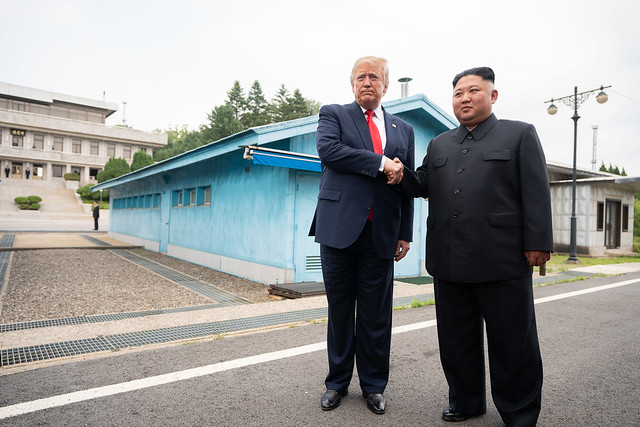 Photo Courtesy: The White House on Flickr
Photo Courtesy: The White House on Flickr
Nuclear North Korea – Toward Legitimization
On Sunday, President Trump met Kim Jong Un at the Demilitarized Zone between North and South Korea. The main conclusion we can draw from the meeting is the following: North Korea is, and will remain, a nuclear power. The opportunity for potential denuclearization was never realistic without a dramatic change of conventional posture on both sides, and neither side appears quite ready for the necessary changes.
US’ attitude on NK’s nuclear program
Today, North Korea is thought to possess between 20 and 60 nuclear warheads, as well as an unknown number of nuclear-capable missiles.
Up to and including the latest meeting with Kim, the Trump administration’s declared goal regarding North Korea was to achieve the “complete, verifiable and irreversible denuclearization” of the country. Just a few months ago, President Trump stated North Korea would be fully denuclearized by 2021. But this objective may be fading. During their latest meeting, Trump and Kim didn’t even bring up the nuclear subject publicly.
We all knew North Korea wasn’t going to surrender its nuclear program at once, but the Trump administration insisted on an all-or nothing approach that has backed it into a corner where it’s difficult to save face. Had the US attempted a step-by-step approach with North Korea, the two governments could be currently discussing the terms of an arms control treaty and each other’s commitment to non-proliferation. Instead, the entire nuclear issue has become so intractable that it’s difficult to figure out what step is next.
US’ next step
At the end of last week, a report described Trump’s meeting with Kim as the American president’s attempt to reach a nuclear freeze of North Korea’s capabilities. If that was true, it would mean the US has accepted North Korea’s nuclear status on the international stage. Such a nuclear freeze program would require North Korea to halt production of all new nuclear weapons and materials. It would not, however, achieve a nuclear reduction – let alone a denuclearization.
The State Department’s envoy to North Korea Stephen Biegun said his team isn’t “preparing any new proposal,” regarding nuclear issues in the country. National Security Adviser John Bolton reiterated, denying that the National Security Council is working on any nucelar freeze agreement. Whether a different government institution is, though, remains a mystery.
Love letter diplomacy
Trump seems to be putting a great deal of emphasis on his personal relationship with Kim. Suffice it to say he greeted the North Korean leader by calling him “my friend,” and saying that meeting him again was an honor.
While an improvement in diplomatic relations is always welcomed, Trump’s claim that, when it comes to North Korea, “we are a lot safer today” than we were before he took office is simply untrue. The nuclear situation on the peninsula has not changed. Trump’s love letters to Kim might help establish a personal relationship between the two leaders, and can actually be useful in lowering tensions to the point that Kim feels he can consider making nuclear compromises, but they aren’t enough on their own to solve the problem.
Political strategy
This third Trump-Kim meeting was intended as a political move to strengthen the two leaders’ public images. While it seemed to have worked for Kim, Trump’s strategy wasn’t as successful. All Trump achieved was a tighter relationship with the North Korean president – while this is a useful step in terms of making Kim feel safer and thus less-likely to need nuclear weapons, the meeting itself didn’t result in any sort of deal or agreement.
It’s likely the Trump administration’s next move will be highly orchestrated. One option is that the administration could confirm a plan for a nuclear freeze, and take credit for a gradual ease of the tensions with North Korea. Another one is that it will reaffirm it does not intend to settle for any agreement other than a complete denuclearization, in an attempt to re-establish its image as firm and authoritative. But what then? Does that mean a return to “fire and fury?”
Back to the start
The Trump administration’s apparent change of heart about the degree of threat represented by North Korea’s nuclear arsenal might lead to fulfilling Kim’s wishes of legitimizing North Korea as a nuclear state, and to obtaining sanctions relief.
Regardless of who wins the next US election, the President is likely to be in the same situation Trump found himself in when he first came into office: North Korea will still have nukes. And, even if Trump came to a deal with North Korea, his successor could potentially tear it up if they find it unsatisfactory, just like Trump did with Obama’s JCPOA. To avoid this, the Trump administration would have to sign a treaty with Kim’s government, and have the Senate ratify it.
While he might have increased the US’ profile in the diplomatic relationship with North Korea, President Trump has yet to achieve an actual nuclear agreement. In the meantime, North Korea’s nuclear stockpile remains intact.





